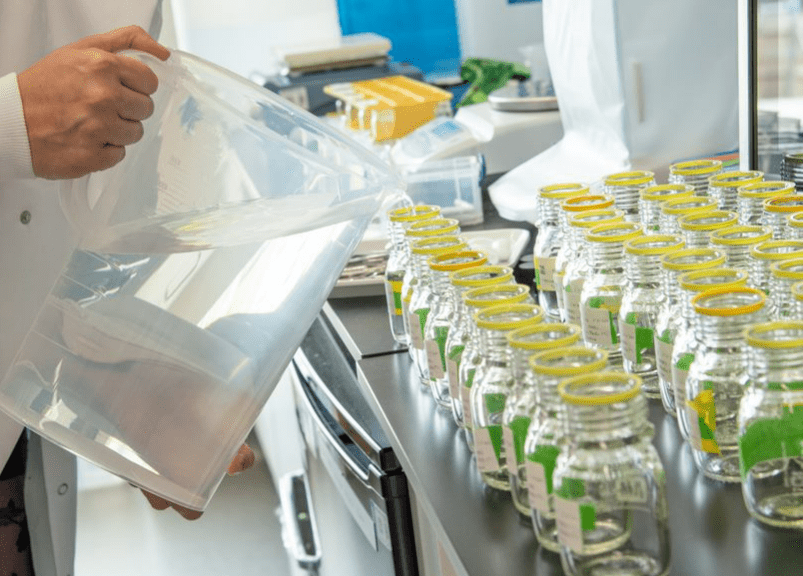UK-based ag biotech startup Moa Technology has raised £35 million ($44 million) for its latest funding round, AFN can exclusively reveal. It’s aiming to tackle the growing problem of herbicide resistance by taking a new approach to the discovery of effective and sustainable alternatives.
The Series B round was co-led by a new investor, London-based Lansdowne Partners, alongside existing UK investors Oxford Sciences Innovation and Parkwalk Advisors. Other early Moa backers including Chinese agrifoodtech VC Bits x Bites, the UK’s Business Growth Fund, and publicly traded IP Group also joined the round.
Moa was spun out of Oxford University‘s plant sciences department in 2018, based on research conducted by co-founders Liam Dolan and Clément Champion.
The company is tackling a problem that’s “similar to the challenge around antibiotic resistance,” Moa CEO Virginia Corless, told AFN. “A very limited number of chemistries have been deployed for years and they’re now losing efficacy because weeds have developed resistance.”
A 2018 study published in Nature suggested that the economic cost to the UK’s agriculture industry of blackgrass — a weed that affects wheat cultivation — had doubled due to the evolution of herbicide resistance. These costs come in the form of increased farmer spending on agro-chemicals and their application, as well as reduced wheat yields. Resistance had evolved in tandem with the growing amount of herbicide used by farmers, the study found – indicating the self-fulfilling nature of the issue.
It’s “a huge problem that farmers are facing every day, and they’re really reaching the end of the road [with existing herbicides.] We want to replenish that toolbox.”
Modes of action
While many other crop protection startups focus on developing biological alternatives to conventional chemical inputs, Moa Technology is instead seeking new modes of action (MoAs) – that is, new routes for herbicidal compounds to attack weeds’ cells.
When a cell in a plant, animal, or other organism is exposed to an active substance, the MoA is the specific biochemical interaction between the substance and the cell that results in a pharmacological effect on the organism; in the case of herbicides, the intended effect is the death of the relevant weed. Often, the MoA involves the targeting of a specific area of the cell in order to produce this effect or to optimize it. This process is at the root of how many pharmaceuticals, pesticides, and herbicides work.
In the herbicide industry, the same handful of MoAs has been used for decades – contributing to the growth of resistance among weeds.
Moa’s tech platform “is revolutionary because no-one else can search for MoAs at such a high rate, and no-one can do it in plants,” Corless says.
“In the first 18 months of searching, we found 25 mode-of-action areas that have never been commercialized; to put that into context, in the whole history of herbicide use, only 24 have ever been commercialized. So 25 is really an unprecedented discovery rate.”
Miniaturized plants
Moa uses “specialized, miniaturized living plants” to screen multiple chemistries and biologicals at speed in order to determine which may have efficacy as herbicides, Corless explains.
“They are whole plants, but they are very small, such we can test chemistries on them as whole populations rather than as single plants. Then we can [use] high-content microscopy to observe the impact of the chemicals we test on them, and through that identify the mode of action and whether its already commercial, or a new one.”
This is in contrast to conventional screening scenarios, in which one compound, working via one MoA, is tested.
Moa is now approaching the point at which some of the leads it has discovered can be taken into the next phase of R&D. In selecting which leads to follow up on, the team considers a “holistic picture,” Corless says.
“Safety is obviously top of the list, jointly with efficacy. Then we also look at things like selectivity: which crops could you use this on based on its intrinsic properties. We look at commercial considerations – is this a molecule that will be relatively easy to produce, [and] is there a good business case in terms of production costs.”
“This challenge around resistance is connected to the bigger story around sustainability and soil health,” she adds. “Herbicides are an essential part of most low- and no-till farming systems, which are the gold standard for carbon sequestration. So we are looking to build tools that can help [encourage adoption] of those practices.”
“Prolific pipeline”
Much of the startup’s Series B haul will be “dedicated to developing those leads into candidates: proving that they really work; they can break resistance; and have great commercial prospects,” Corless says.
“The Series B round is about optimizing those leads into safe, efficient molecules that will ultimately end up on farmers’ fields. In the next few years, we will be focused on that optimization process, having those initial hits [showing] activity in the glasshouse [then] testing them in the field, and a lot of work on safety […] Then, after that, preparing for the regulatory process and working through that.”
When it comes to revenue models for eventually commercializing these candidates, for Corless, it’s “too early to say.”
“What we see right now is a prolific pipeline with a great diversity of MoAs, and the next two years is really about figuring out where those opportunities are. Right now we aren’t targeting one specific crop or one specific weed, because the problem [of resistance] is so widespread.”
“This funding will allow us to push ahead and pursue a range of potential opportunities: joint ventures, partnerships, out-licensing, or taking a portfolio to market ourselves as a new entrant in this space.”




